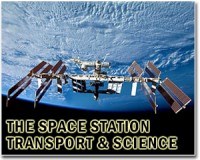 |
Moscow (RIA Novosti) Oct 28, 2010 Russia's Progress M-05M cargo spacecraft was undocked from the International Space Station (ISS) on Monday to begin an independent scientific mission until November 15, a Mission Control spokesman said. "The space freighter will continue an autonomous flight as a scientific laboratory until November 15 when it will be deorbited and 'buried' in a remote area in the southern Pacific," the official said. The undocking of Progress M-05M clears the way for the launch of the Progress M-08M spacecraft on October 27 from the Baikonur space center in Kazakhstan. On October 30, Progress M-08M is expected to dock with the Pirs docking module vacated by Progress M-05M. Progress-family freighters have been the backbone of the Russian space cargo fleet for decades. In addition to their main mission as cargo spacecraft, they are used to adjust the ISS's orbit and conduct scientific experiments.
earlier related report Russia launched a Soyuz carrier rocket with the Progress M-08M cargo spacecraft at 7:11 p.m. Moscow time (15:11 GMT) on Wednesday from the Baikonur Space Center in Kazakhstan. "The freighter has separated from the third stage of the Soyuz launch vehicle...All on-board systems are operating normally," a Roscosmos spokesman said. The freighter is expected to dock with the ISS on October 30. Progress-family freighters have been the backbone of the Russian space cargo fleet for decades. In addition to their main mission as cargo spacecraft, they are also used to adjust the ISS's orbit and conduct scientific experiments.
International Space Station Water System Successfully Activated The Sabatier system can create up to 530 gallons of water per year from byproducts of the station's Oxygen Generation System and Carbon Dioxide Removal Assembly. The process is named for Paul Sabatier, a 1912 Nobel Prize winner in chemistry. "This is an important step forward in NASA's commercialization endeavors and shows how successful private industry can be at providing solutions on its own," said Bill Gerstenmaier, NASA associate administrator for Space Operations at the agency's Headquarters in Washington. "The ability to produce this water will be important for sustaining space station operations once the shuttle is retired." The system was integrated into the space station's Water Recovery System during the week of Oct. 11. Activation, checkout and first use of the system were completed Oct. 22, running for over eight hours. The Sabatier process uses a nickel catalyst to interact with hydrogen and carbon dioxide at elevated temperatures and pressures to produce water and methane. The water is retained for recycling processes, and the methane is vented outside of the space station. Prior to adding the Sabatier system, hydrogen produced while generating station oxygen was considered waste gas and vented overboard. Carbon dioxide generated by crew metabolism also was vented overboard. With the Sabatier system, these two former waste gases will generate a valuable product for the space station: water. Under contract to NASA, Hamilton Sundstrand supplied the flight hardware and operational support for a Sabatier-reaction-based system that operates as part of the station's Environmental Control and Life Support System. This contract is unique because NASA did not participate in design reviews or impose any specifications on the design, except for those defined in the safety, interface and acceptance requirements met by Hamilton Sundstrand. The company developed, procured, and built the flight hardware and support equipment needed for operations and training. The in-orbit operational portion of the contract runs until Sept. 30, 2014.
Share This Article With Planet Earth
Related Links - Station at NASA Station and More at Roscosmos S.P. Korolev RSC Energia Watch NASA TV via Space.TV Space Station News at Space-Travel.Com
 EU mulls opening ISS to more countries
EU mulls opening ISS to more countriesBrussels (UPI) Oct 27, 2010 European countries not a part of the International Space Station program will be allowed access to the station in a three-year trial period, officials say. European Space Agency officials say non-participating countries will be able to place experiments on the orbital complex in a trial that could provide a fresh revenue source for the project, SPACE.com reported Wednesday. The p ... read more |
|
| The content herein, unless otherwise known to be public domain, are Copyright 1995-2010 - SpaceDaily. AFP and UPI Wire Stories are copyright Agence France-Presse and United Press International. ESA Portal Reports are copyright European Space Agency. All NASA sourced material is public domain. Additional copyrights may apply in whole or part to other bona fide parties. Advertising does not imply endorsement,agreement or approval of any opinions, statements or information provided by SpaceDaily on any Web page published or hosted by SpaceDaily. Privacy Statement |